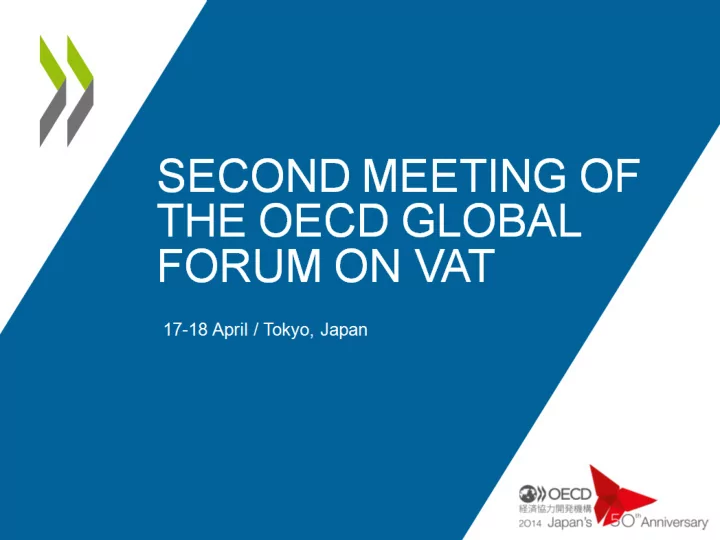

THE VAT — EQUITY, POLITICS AND MACROECONOMICS Michael Keen OECD Global Forum on VAT, Tokyo April 18, 2014
Focus on two sets of issues: • How to reconcile effectiveness of VAT as revenue source with distributional concerns? • What role in improving macro performance? – ‘Fiscal devaluation’ – Is the VAT (relatively) growth friendly’?
DISTRIBUTIONAL POLICY AND THE VAT
Policy arguments for differential rates • Efficiency – Lower rates where this encourages paid labor • Child care? – But empirical evidence weak, so leave this aside • Distribution – Lower rates on items important to the poor But ….
Two steps…. ....to rejecting reduced rates on equity grounds • Step One: Reduced rates are very a badly targeted way of helping the poor – the poor spend a larger proportion of their income on (say) food, but the rich spend absolutely more
For instance, zero rate on food in Mexico: 25 20 15 10 5 0 I II III IV V VI VII VIII IX X Percent of total subsidy Percent of income
But this in itself does not prove reduced rate undesirable — also need: • Step Two: Show there is some other, better way to protect the most vulnerable This will very often be the case in advanced economies. In the UK for instance,….
Eliminating zero rate and increase benefits — poor better off, and net revenue gain £10.00 3.00% £5.00 1.50% Average Tax Gains/Losses Average Tax Gains/Losses £0.00 0.00% (% of disposable income) 1 2 3 4 5 6 7 8 9 10 -£5.00 -1.50% (£'s p.w.) -£10.00 -3.00% -£15.00 -4.50% -£20.00 -6.00% -£25.00 -7.50% -£30.00 -9.00% Income deciles Average Tax Losses (£'s p.w.) Average Tax Losses (% of disposable income)
• What about developing economies? Only blunter spending instruments available, so policy case for differentiation stronger — but how strong? Poorest gain from increasing rate on ‘food’ if and only if: Proportion of all food they consume Exceeds Their marginal benefit from $1 of public expenditure
For instance: • Gain if revenue raise used to pay a poll subsidy • In India example below, bottom 20 percent benefit from increased spending on curative health care if they account for less than 10 percent of ‘food’ consumption 40.0% 33.1% 30.0% 25.6% 20.0% 17.8% 13.4% 10.1% 10.0% 0.0% Poorest 2nd Middle 4th Richest 20% 20% 20%
The moral is: • Rate reductions are so badly targeted on poor that spending doesn’t have to be very well targeted to be a better way to help them
So why are reduced rates so common? ...especially for older VATs: Number of new VATs Proportion born with a single rate Before 1990 48 25% 1990-1999 75 71% 1999-2011 31 81%
• Governments’ lack of understanding/communication? – especially latter Transparency alone not enough • Resistance from higher income groups – May understand very well! • Signals how much policy makers care about poor, precisely because it is inefficient – A bit subtle….
• Doubts that compensation will be paid – Iran subsidy example: cash up front – Earmarking as a solution? • Examples: Ghana, proposed for US VAT • But either (a) constrains spending or (b) is misleading and non-transparent A last resort? • Hold out for even more progressive ways to finance same spending
Successes? • Crisis hasn’t helped: For 28 advanced since 2009 VAT increases Social contribution cuts 17 3 15 2 1 • Moral: Mistakes are hard to correct!
FISCAL DEVALUATION
What is it? With fixed exchange rate, tax changes can mimic a devaluation: • A fiscal devaluation is a reveneu-neutral shift from employer’s social contributions (SCR) towards consumption taxes (especially VAT)
How does it work in principle? At fixed exchange rate: • Lower SCR reduces foreign currency price of exports • Consumer prices of domestically produced goods unchanged: higher VAT offsets lower SCR • Consumer prices of imports rise due to higher VAT NB: Expect effect to be temporary, especially where exchange rate flexible
Does it work in practice? For a panel of 30 OCED countries over 40 years, results not entirely robust but suggest: • For euro countries, a shift from SCR to VAT of one percentage point of GDP might raise net exports by 3 to 4 percent in short run – Effect is temporary but quite long-lasting • Less marked for non-euro/flexible ER countries
Impact on net exports over time (in % GDP) 10 8 Effect on net exports in percent of GDP 6 4 2 Point estimate 0 1 6 11 16 21 26 31 36 41 46 -2 -4
Policy implications? • Few have done FD in the crisis – Many have increased SCRs Why? • Significant additional considerations – Compensating e.g. pensioners reduces funds available to cut SCR – Maintain contributory principle
• May need big tax switch to have marked effect – And hence risky But: • Even if no effect on net exports, end up with more growth friendly tax system – Evidence that heavier reliance on VAT associated with faster growth • Though structure must matter — with signs that base broadening better for growth than rate increase
Recommend
More recommend